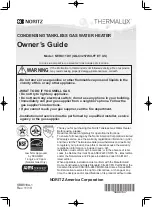
47
9
Maintenance
(continued)
Check burner flame
1. Inspect flame through observation window.
2. If the flame is unsatisfactory at either high fire or low
fire, turn off water heater and allow water heater to
cool down. Remove the burner and clean it thoroughly
using a vacuum cleaner or compressed air. Do not use
compressed air to clean burner if performed inside a
building.
3. Remove the burner, reference FIG. 9-2 below.
4. When replacing the burner, ensure gasket is in good
condition and positioned correctly (FIG. 9-2).
IMG00447
AIR / GAS ARM
SCREWS
(QTY. 5)
GASKET
BURNER
HEAT EXCHANGER
ACCESS COVER
INSULATION
Figure 9-2 Burner Assembly
Perform start-up and checks
1. Start water heater and perform checks and tests specified
in
Section 7 - Start-up
.
2. Verify cold fill pressure is correct and that operating
pressure does not go too high.
Check flame signal
1. At high fire the flame signal shown on the display should
be at least 10 microamps.
2. A lower flame signal may indicate a fouled or damaged
flame sense electrode. If cleaning the flame sense electrode
does not improve, ground wiring is in good condition,
and ground continuity is satisfactory, replace the flame
sense electrode.
3. See Section 3 - Troubleshooting in the Outdoor Armor
Service Manual for other procedures to deal with low
flame signal.
Review with owner
1. Emphasize the need to perform the maintenance schedule
specified in this manual.
2. Remind the owner of the need to call a licensed contractor
should the water heater or system exhibit any unusual
behavior.
The water heater contains ceramic fiber
materials. Use care when handling these
materials per instructions in the Service
Manual. Failure to comply could result in
severe personal injury.
WARNING
Cleaning heat exchanger
For recommended materials; including brush, appropriate
extension(s), refractory cover, and detailed instructions see
Table 9B - Heat Exchanger Cleaning Kits.
1. Shut down water heater:
• Follow the “To Turn Off Gas to Appliance” instructions
for the water heater in
Section 7 - Startup
.
2. Allow time for the water heater to cool to ambient
temperature if it has been firing.
3. Remove the nuts securing the heat exchanger access cover
to the heat exchanger and set aside.
4. Remove the heat exchanger access cover, burner, and
gas/air arm assembly.
5. Remove the condensate hose from the heat exchanger end.
Connect a field supplied 3/4" diameter hose to a drain pan.
Using field supplied means, cover the refractory in the back
of the combustion chamber of the heat exchanger.
6. Use a vacuum cleaner to remove any accumulation on the
water heater heating surfaces. Do not use any solvent.
7. Brush the heat exchanger while dry using a nylon bristle
brush.
Caution:
DO NOT use a metal brush. Re-vacuum
the heat exchanger.
8. Finish cleaning using a clean cloth dampened with warm
water. Rinse out debris with a low pressure water supply.
9. Allow the heat exchanger to thoroughly dry.
10. Remove the field supplied rear refractory cover from the
back of the combustion chamber of the heat exchanger and
reassemble.
11. Close isolation valves on piping to isolate water heater from
system. Attach a hose to the water heater drain and flush
water heater thoroughly with clean water by using purging
valves to allow water to flow through the water make-up
line to the water heater.
12. Perform start-up and check-out procedures in the Check
Flame and Combustion -
Section 7 - Startup
on pages 31 and
34 of this manual.
13. Replace the access cover and restore water heater to
operation.
3. Remind the owner to follow the proper shutdown procedure
and to schedule an annual start-up.
Outdoor Armor Water Heater
Installation & Operation Manual





































